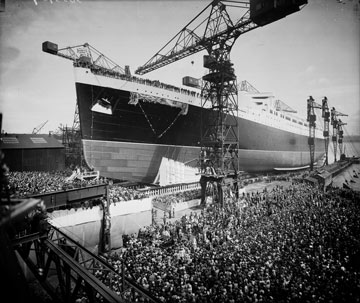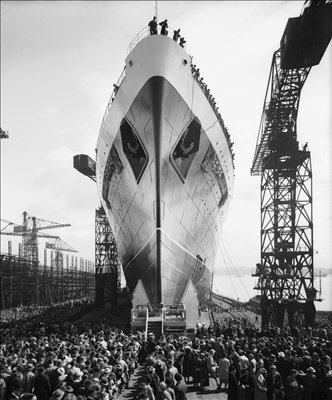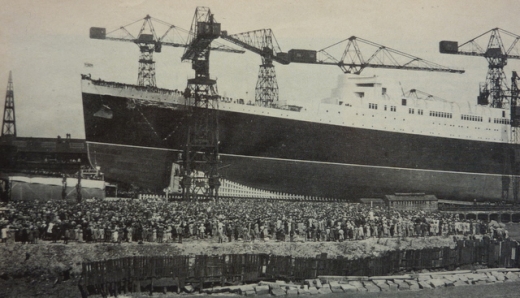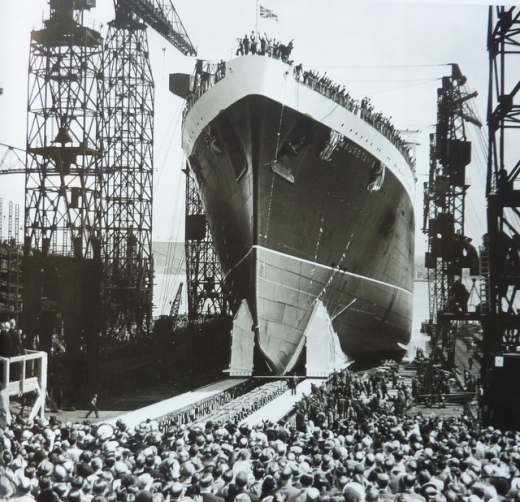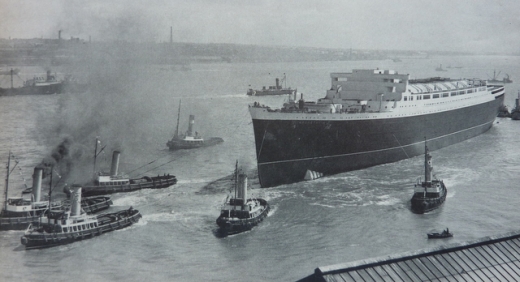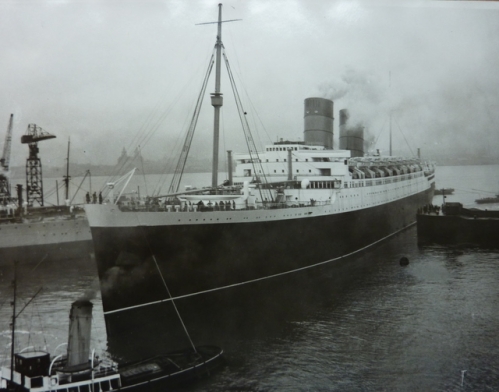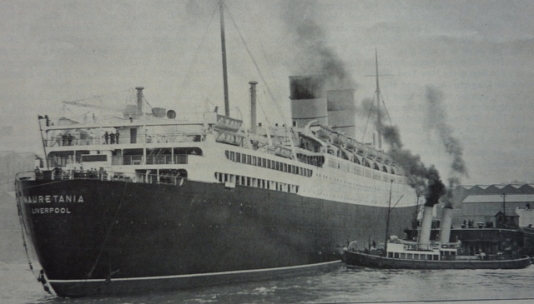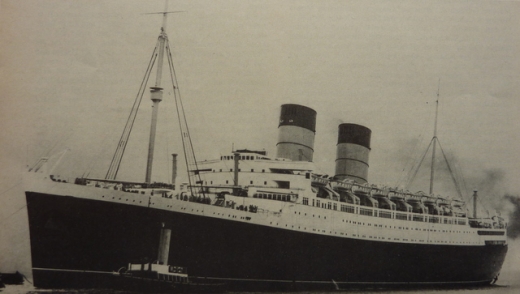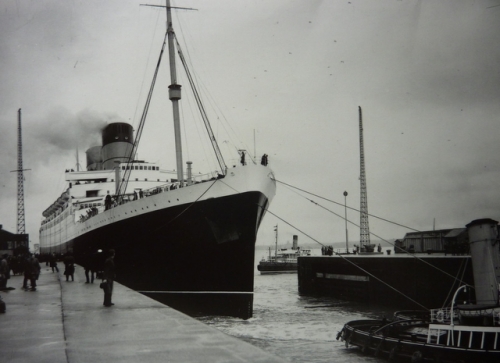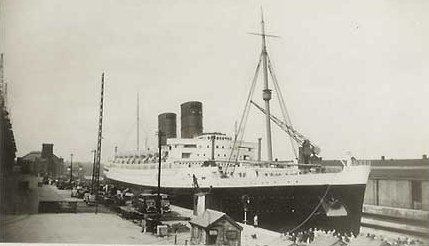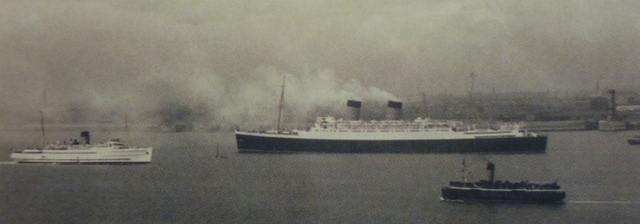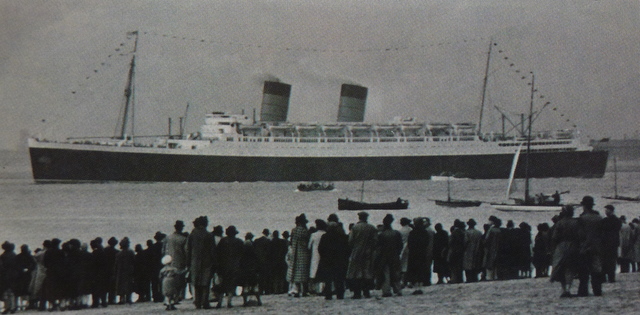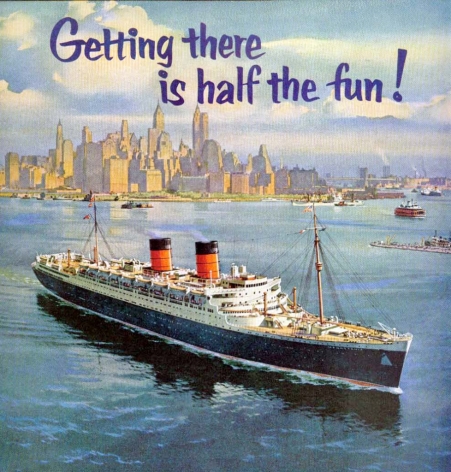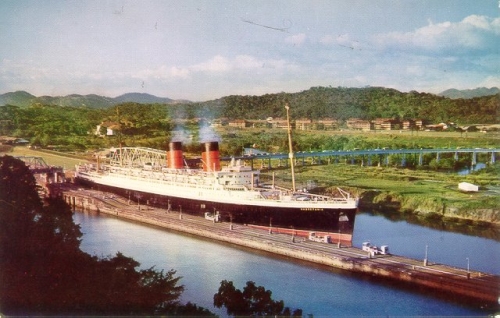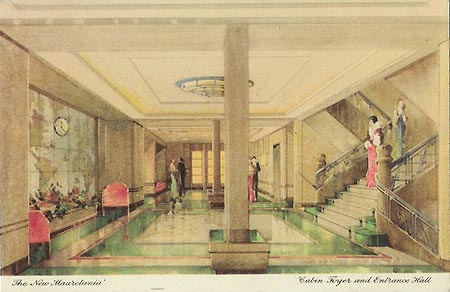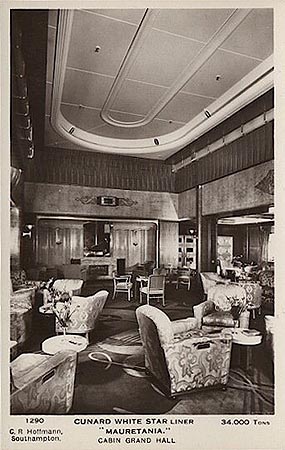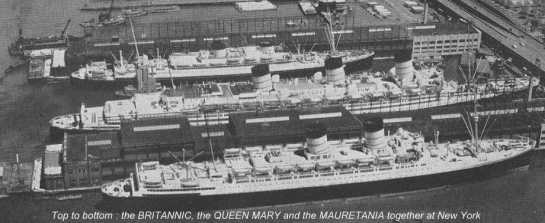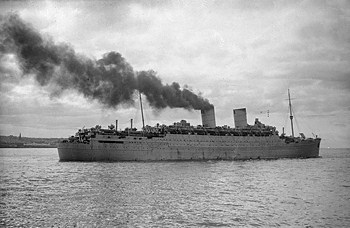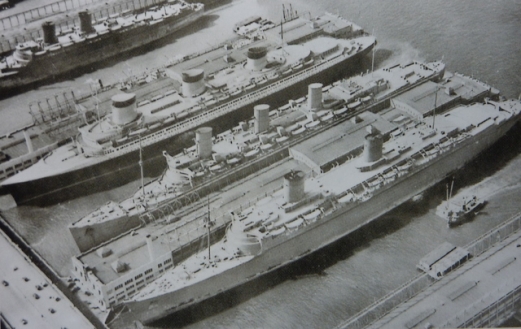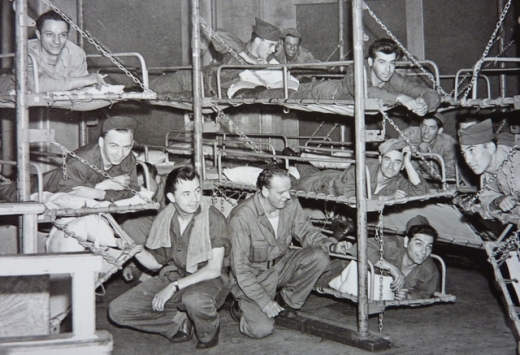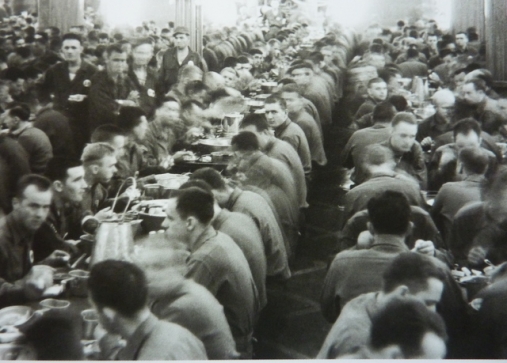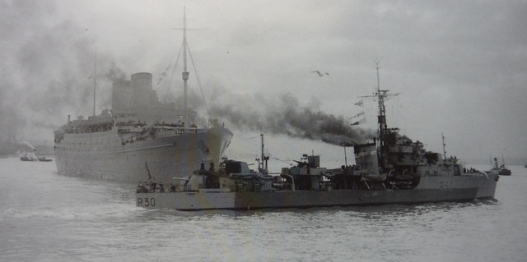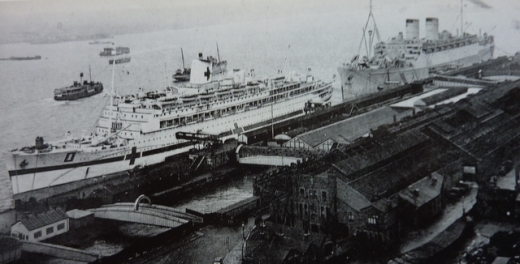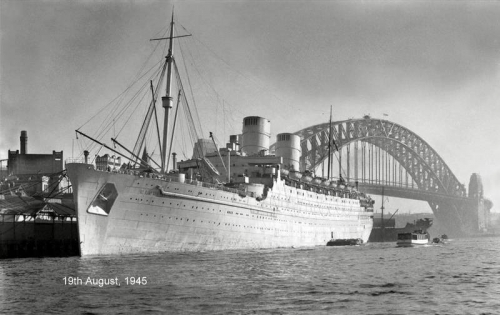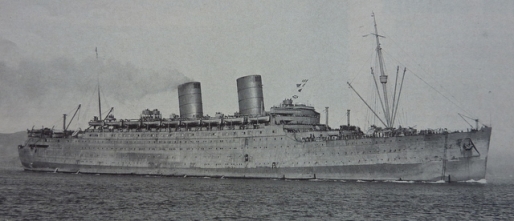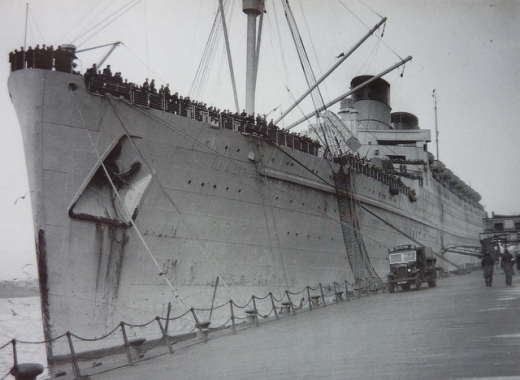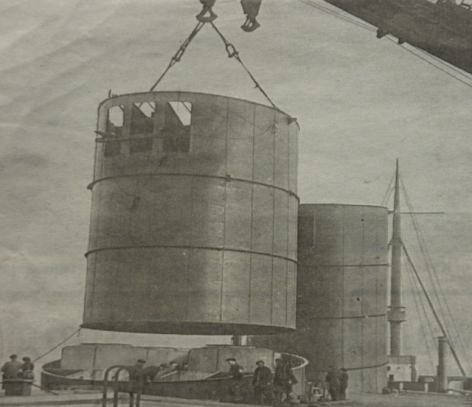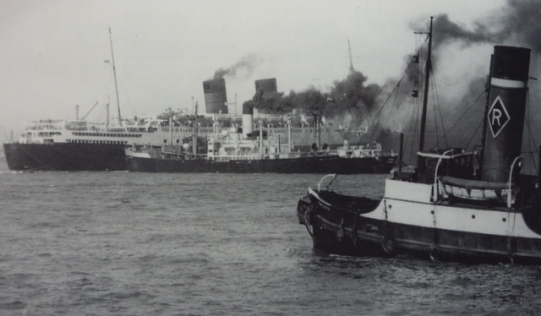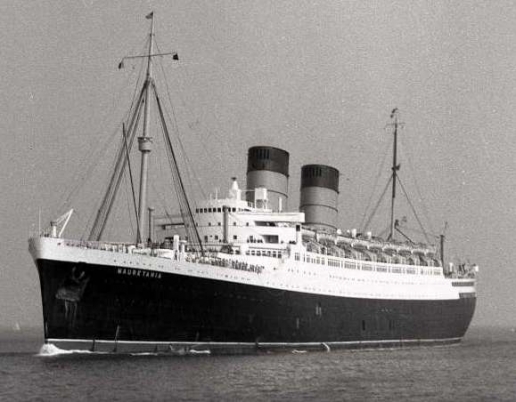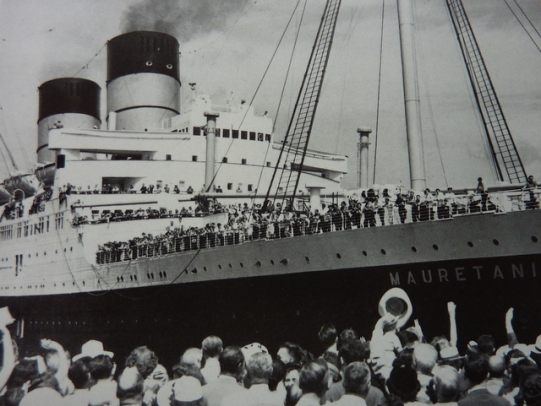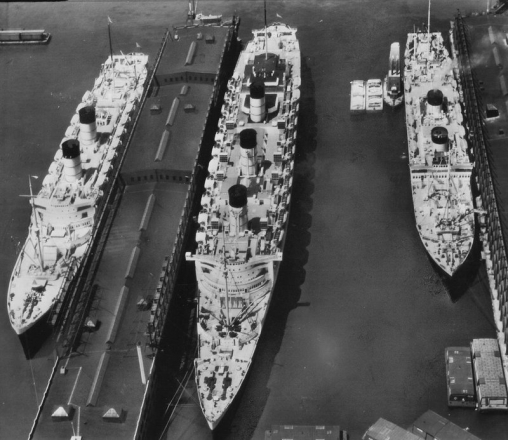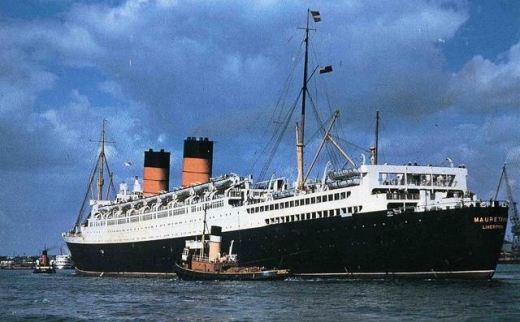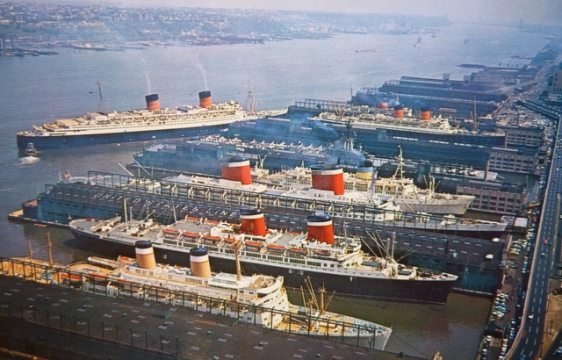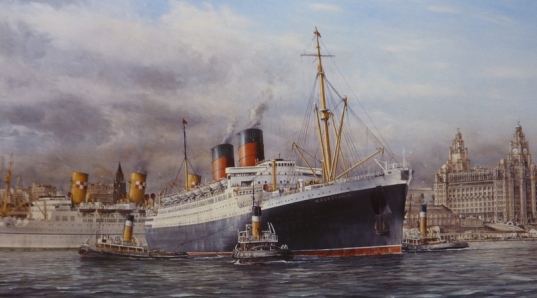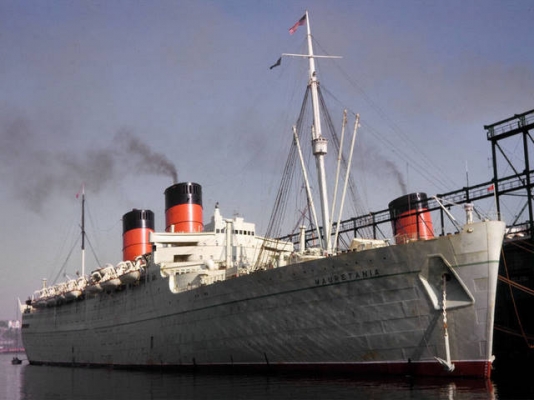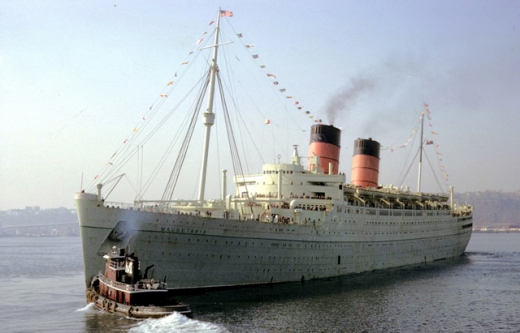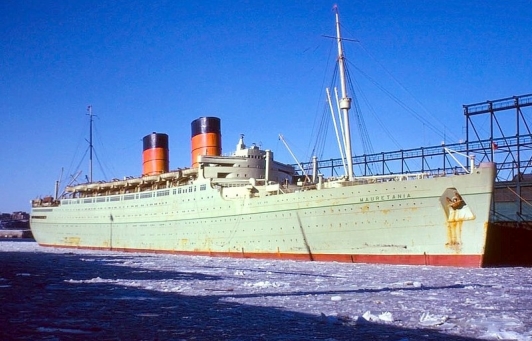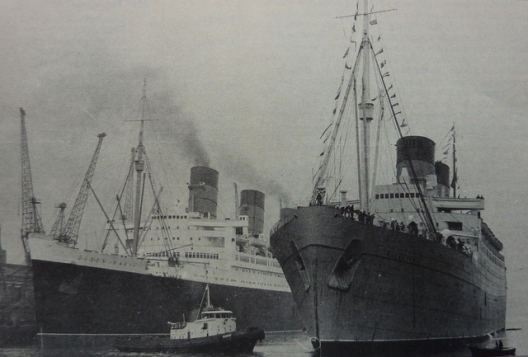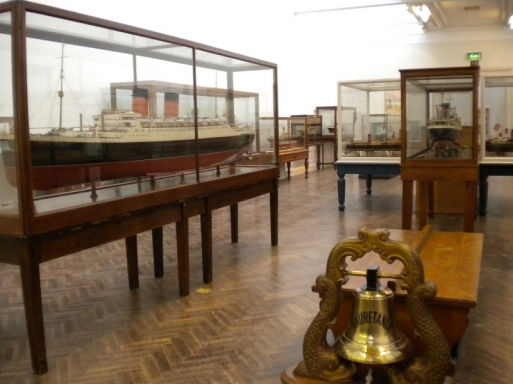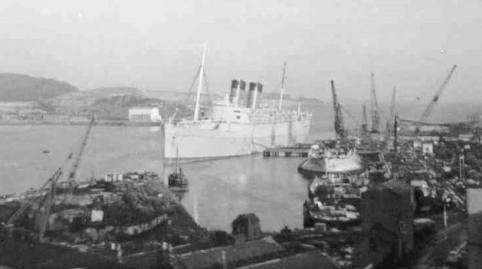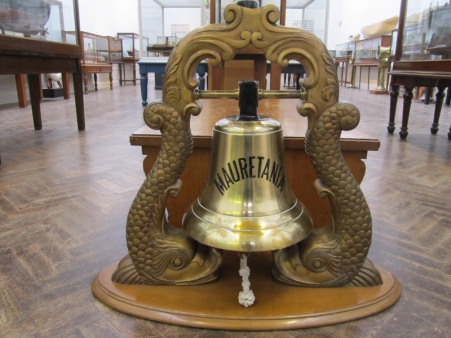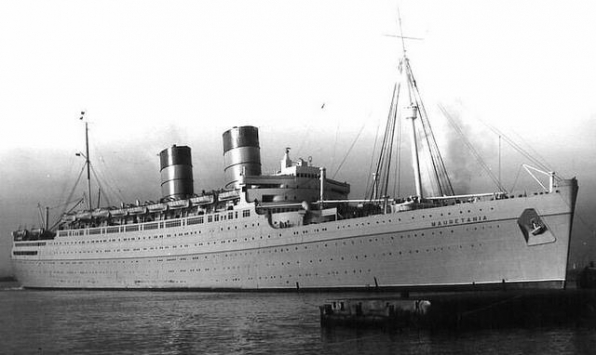LIVERPOOL SHIPS
THE CUNARD LINER 'MAURETANIA' OF 1939
The Cunard liner MAURETANIA of 1939 was built on the Mersey by Cammell Laird at Birkenhead. She was only the third Cunard passenger liner to be built on the Mersey, the other two being the CEPHALONIA (1882), and the SAMARIA (1921).
The MAURETANIA passing the QUEEN MARY in mid-Atlantic (from an original painting by Robert Lloyd)
Although the MAURETANIA's visits to the Mersey were very few and far between during her career, she is included on this website as the Mersey was her birthplace.
The MAURETANIA leaving New York in 1963 in her 'cruising green' colours. Note the tower (on the left) and the suspension cables for the new Verazzano Narrows Bridge, then in the course of construction.
In June 1936, Cunard White - Star announced that it had placed an order with Cammell Laird & Co. Ltd. at Birkenhead for a passenger liner of 35,000 gross tons intended for a service between London (cargo only), Southampton, Le Havre and New York. There were several interesting features about this news. It was the first order placed by Cunard - White Star Ltd. (formed in 1934); there was no Government assistance involved; the new liner would be the largest merchant ship ever to be built in an English shipyard; and finally, although the Cammell Laird shipyard was only a river's width away from the Cunard head office, the new ship would be only the third Cunard liner built on the Mersey.
(from an original painting by Robert Lloyd)
The first keel section was laid on 24th May 1937 on No.6 slipway, birthplace of HMS RODNEY, HMS ARK ROYAL and the SAMARIA. Work proceeded well and on 23rd October 1937 Sir Percy Bates, the Cunard chairman, announced that his wife would launch the ship on 28th July 1938, and that it had been decided to name the new liner MAURETANIA, "thus reviving a name which has been made famous the world over by her distinguished predecessor." This proved to be something of a mixed blessing, and whilst giving the new ship immediate recognition, it meant that she had to live up to an unsurpassed maritime legend.
The first MAURETANIA - 'an unsurpassed maritime legend' - leaving Liverpool on her maiden voyage to New York at 7.30pm on Saturday, 7th November 1907.
____________________________________________________________________________________
When the old MAURETANIA was sent to the breakers' yard at Rosyth in July 1935 and her name removed from Lloyd's Register, Cunard wanted to safeguard the famous name for its new liner. So the Cunard Company approached the local Southampton company Red Funnel Steamers, and asked its Directors to rename an excursion paddle steamer MAURETANIA so as to keep the name available. And so it was - the South Coast excursion steamer QUEEN was renamed MAURETANIA from 1st April 1936 until November 1937.
_______________________________________________________
The new MAURETANIA was launched by Cammell Laird at Birkenhead on 28th July, 1938:
Huge crowds gather to watch the launch at Birkenhead on 28th July 1938
The new MAURETANIA moving down the slipway at Cammell Laird's yard at Birkenhead, following her naming ceremony which was performed by Mrs Percy Bates, the wife of the Cunard Line chairman, on 28th July 1938.
The MAURETANIA in the Mersey immediately after her launch __________________________________________ British Pathé newsreel footage of the launch of the MAURETANIA can be viewed at:
www.youtube.com/watch?v=hSOGM6WZ9mY
The compiler of this video clip has got his two MAURETANIAs totally mixed up, but notwithstanding, it's worth a look! ____________________________________________
On the appointed day a crowd of about 40,000 people assembled to witness the launch, while many more, each paying two shillings (10p) crowded the decks of four Mersey ferry steamers to view the spectacle. At 12.15pm, with gathering momentum, the great steel hull, weighing with the launching cradle 18,000 tons, slid down the ways and within fifty seconds was safely waterborne. Nine tugs then converged on her and within a short time the MAURETANIA was safely berthed in Cammell Laird's wet basin. Work on the completion and the fitting-out of the MAURETANIA proceeded apace and at one stage over 3,000 men were engaged on the ship. Progress was such that on 17th November 1938 the Cunard - White Star Company was able to announce that the MAURETANIA's maiden voyage would leave Liverpool for New York on 17th June 1939.
The new MAURETANIA leaving Cammell Laird's fitting-out basin on 14th May 1939
The rudderless MAURETANIA is assisted by tugs on the passage from Cammell Laird's fitting-out basin at Birkenhead to the Gladstone Graving Dock at Bootle (on the Liverpool side of the Mersey) on 14th May, 1939.
The MAURETANIA arriving in the Gladstone River Entrance Lock on 14th May 1939.
The MAURETANIA in the Gladstone Graving Dock in May 1939 where her rudder was fitted.
On 14th May 1939 the new liner was taken out of Cammell Laird's wet basin and, with the aid of six tugs, escorted across the Mersey and through the Gladstone River Entrance Lock and into the Gladstone Graving Dock - no mean navigational feat! It was here that her 50-ton rudder was fitted. Just over a fortnight later, on 31st May, the MAURETANIA left Liverpool for her acceptance trials which were undertaken in the Firth of Clyde. In command was Captain A.T. Brown, RD, RNR. The trials were completed to the satisfaction of the builders and the prospective owners. They were run over the 'Arran Mile' and the MAURETANIA recorded a run of 25.34 knots at 47,800 shp. The MAURETANIA returned to Liverpool where she was formerly handed over to Cunard - White Star. Obviously pleased, Sir Percty Bates commented: "There has never been a Cunard ship which has gone through her trials with less trouble, with less fuss - almost an air of casual ease - than this ship has done." Statistically, the new MAURETANIA was the twelfth largest and the sixth fastest liner in the world in 1939.
_______________________________________________________
MAURETANIA Official Number: 166267 Signal Letters: G T T M Gross Tonnage: 35,674, Nett: 19,654 Length: 739.4 feet Breadth: 89.4 feet Owned by the Cunard Steamship Co. Ltd; registered at Liverpool 6 steam turbines; single-reduction gearing to twin screws
________________________________________________________
The MAURETANIA leaving Liverpool on her maiden voyage. Above: note the white painted Isle of Man ferry MONA'S QUEEN, and Below: Crowds turn out to see the new Cunard - White Star liner pass New Brighton.
The MAURETANIA left Liverpool on 17th June 1939 as planned, with over 1,000 passengers on board and arrived at New York early in the morning of Saturday 24th June. As she steamed up the Hudson she received the traditional New York harbour welcome. The return voyage from New York to Southampton, with a call at Cherbourg, carried a full complement of passengers and the new ship arrived at Southampton on 7th July. Her times for the round voyage are as follows:
WESTBOUND: Mersey Bar Lightship to Ambrose Channel Light Vessel at New York: 5 days, 21 hours, 40 minutes; average speed 20.60 knots (including a stay at Cobh of 4 hours and 24 minutes).
EASTBOUND: Ambrose Channel Light Vessel to Cherbourg: 5 days, 22 hours, 22 minutes; average speed: 22 knots.
The MAURETANIA passing through the PanamaCanal
On 6th August 1939 the MAURETANIA arrived in London's King George V Dock. More than 100,000 people watched the 2 hour, 45 minute passage from Tilbury, with London pilot Harry Stowers on the bridge. The MAURETANIA cleared the entrance lock with just 42 inches to spare on either side. The new ship was the largest ever to enter the King George V Dock, and this was the one and only occasion that she did so. On 12th August 1939 the MAURETANIA left London for Southampton, Le Havre and New York, where she arrived on 18th August with 1,152 passengers. The next day she sailed on a six-day cruise to Nova Scotia and Bermuda.
The European situation was deteriorating, and the MAURETANIA left New York on 26th August with 740 passengers. There had been 262 cancellations. The news of Germany's invasion of Poland on 1st September was received in mid-Atlantic, and the MAURETANIA was ordered to proceed directly to Southampton, and to omit the call at Cobh. She arrived on the day war was declared, 3rd September 1939.
for a safe haven in New York on 10th December 1939.
The MAURETANIA was hastily painted grey and armed with two 3-inch and one 6-inch gun. She left Southampton on 14th September and reached New York six days later with 698 passengers on board, including Joseph P. Kennedy Jr., the son of the U.S. Ambassador to Great Britain. The MAURETANIA sailed from New York on 30th September, bound for Liverpool with148 passengers, and on arrival she was laid up in the Gladstone Dock. However, with the ever present risk of a Luftwaffe attack, the MAURETANIA sailed back to New York on 10th December 1939 with 166 passengers and 2,000 tons of cargo, arriving on the 16th, and was laid up at Cunard's Pier 90.
together at New York. Top left: the MAURETANIA on Pier 86; centre: the French Line's NORMANDIE on Pier 88; and bottom, on Pier90, the QUEEN MARY and the QUEEN ELIZABETH.
The MAURETANIA's New York refuge was brief. On 6th March 1940 the Ministry of War Transport requisitioned her as a troopship, and on that day also she shifted berth from Pier 90 to Pier 86 to make way for the QUEEN ELIZABETH's surprise arrival the next day, after her 'secret' voyage from the Clyde. On 18th March the ANTONIA arrived with additional crew for the MAURETANIA, and at 8.pm on 20th March she sailed from New York to commence her war service. A marine news report at New York reported: "8.52pm. A British ship, no signals, passing Quarantine, bound out."
After a call at Bermuda and passing through the Panama Canal on 27th March, the MAURETANIA bunkered at Honolulu on 5th April and arrived at Sydney on 14th April. In just three weeks at the Cockatoo Island Dockyard, her luxury staterooms gave way to bunks, hammocks and mess tables for as many as 6,500 troops. Her defensive armament was increased to two 6-inch guns, three 12-pounders, three 40mm and twenty-two 20mm anti-aircraft guns, and two rocket launchers.
Cramped conditions in the MAURETANIA's first-class dining saloon for some of the 6,500 troops the ship could carry.
HMT MAURETANIA's first convoy (US3) left Sydney on 5th May 1940, bound for Greenock, where she arrived on 16th June with 2,000 Australian troops. After returning to Durban, the MAURETANIA sailed on the 'Suez Shuttle' - Bombay - Colombo - Durban - Port Tewfik. Almost always unescorted, she sailed on this arduous route from mid 1941 until February 1943, carrying 6,500 men at a time. She had a near-miss during the night of 15th/16th May 1942 when the Durban bound MAURETANIA narrowly averted collision with the Bombay bound ILE DE FRANCE. Normally, the two ships would have passed fifty miles apart, but in a driving monsoon the two ships were on a collision course and only the ILE DE FRANCE's hard-a-starboard turn averted a major catastrophe.
the QUEEN MARY, the QUEEN ELIZABETH and the MAURETANIA (right).
Following the Allied victory in North Africa, the MAURETANIA finally returned to the North Atlantic, and, as part of 'Operation Bolero', she made twenty-one round voyages between April 1943 and March 1945, each carrying as many as 7,124 American and Canadian troops in the build-up for the 'D'-Day landings. On one occasion the MAURETANIA had a 'close-call' off Northern Ireland with 5,500 American GIs on board. Two 'wolf packs' of German U-boats were reported to be closing on the liner from port and starboard. The MAURETANIA put on all speed, but a surfaced submarine was picked up next morning by radar, just five miles ahead. As she turned about, an urgent signal from Western Approaches Command in Liverpool was received - the U-boat had reported the MAURETANIA's position to all other submarines in the area. Steaming at full speed on an intricate zig-zag course, the MAURETANIA evaded her pursuers and safely reached the Clyde.
her way to join another convoy. Her escort is taking up position.
After the end of the war, the MAURETANIA began repatriating Britons from the Far East, and Canadians back to the Dominion. The ship undertook the longest and fastest voyages of her career during this period. On 24th September 1945 the MAURETANIA berthed at Princes Landing Stage, Liverpool, to disembark 4,000 servicemen and 1,000 civilians: it was the first large repatriation from the Far East and received a rousing reception from Merseysiders.
Ahead of her is the hospital ship ORANJE.
There was more to cheer about. The MAURETANIA claimed a round-the-world record: 28,662 miles (U.K. - Panama - Pearl Harbour - Fremantle - Durban - Cape Town - Freetown - Liverpool) in 81 days and 18 hours, and from Sydney to Liverpool in just one month and one day. This record was quickly challenged by the ANDES, which claimed a 26,012 mile circumnavigation, 29th June - 10th September 1945, in 72 days, 8 hours and 56 minutes.
With her funnels repainted in Cunard red, the MAURETANIA left Liverpool on 21st October, and returned to Liverpool with more laurels (and 2,000 Army and 3,000 RAF personnel) on 26th November, after making the 6,200 mile passage from Bombay in just 11 days, 11 hours and 15 minutes at an average speed of 23.4 knots.
The MAURETANIA returned briefly to the North Atlantic, sailing from Liverpool on 5th February 1946 bound for Halifax with the first group of Canadian war brides (400 wives and 364 babies !), and returned with 2,753 German prisoners-of-war. The MAURETANIA made one last voyage to the Far East from Liverpool to Singapore on 26th June 1946. It proved to be another one for the record books: Mersey Bar Lightship to Sultan Shoal, Singapore (8,426 miles) in 16 days, 20 hours and 31 minutes. The homeward passage was even faster at 16 days, 1 hour and 30 minutes. Altogether she had sailed 16,863 miles at an average speed of 23.11 knots.
The MAURETANIA's final voyage as a troopship, from Liverpool to Halifax, N.S., was highlighted by the presence on board of Field Marshall Viscount Montgomery. Weather beaten, scarred and proud, HMT MAURETANIA came home to Liverpool, for the last time in her wartime grey, on 2nd September 1946. Within hours of disembarking her 600 passengers at Princes Landing Stage, the MAURETANIA was moved into the Gladstone Dock to commence the process of returning her to her designed role as a luxury Atlantic liner.
arriving back from Halifax, N.S. She is seen here berthed on Princes Landing Stage, disembarking the last of her wartime passengers.
During the Second World War, the MAURETANIA had carried 350,178 troops and personnel, and had steamed a grand total of 542,446 miles.
For Cammell Laird's 1,500 workforce (many of whom had helped build the ship), the reconversion was almost like starting over again. Rusty grey wartime paint had to be sandblasted off, weathered decking reteaked, worn machinery renewed or replaced, gun emplacements removed, and furniture and fixtures whether stowed as close as Bootle or as far away as Sydney, repatriated and restored. Wartime ballast of 400 tons of pig iron and 700 tons of sand had to be removed. The Mersey Docks & Harbour Board's floating crane MAMMOTH removed the 76-ton after funnel on 23rd Setember 1946 to allow access to the engine room. In all, the refit cost £1 million and Cunard - White Star announced on 2nd March 1947 that the MAURETANIA would return to service on 26th April.
removing the MAURETANIA's after funnel
In all respects as good as new, the MAURETANIA sailed from Liverpool on 18th April 1947 on an intended two-night 'shakedown' cruise to the Hebrides for 400 guests of the Company. Instead, the British weather conspired to make this one of the liner's most exacting voyages. Heeding gale warnings, Captain R.G.B. Woollatt brought his ship off the Mersey Bar on 21st April. By then, however, the winds were so fierce that the MAURETANIA was not able to proceed up the sea channels to Liverpool and sought shelter in Moelfre Bay, off the north coast of Anglesey. The anchors were dragging, and so the MAURETANIA had to ride out the storm in the Irish Sea, and it was not until 24th April that she was back alongside Princes Landing Stage. Her crew and shipyard workers had to complete work and storing within forty-eight hours to keep to schedule.
post-war commercial voyage to New York on 26th April 1947, the MAURETANIA came within a few feet of being in collision with the Blue Funnel liner MEMNON, which was'rounding up' to enter the Alfred Lock at Birkenhead.
The MAURETANIA left Liverpool on her second 'maiden' voyage to New York on 26th April 1947. When backing off Princes Landing Stage, which was a difficult manoeuvre owing to the necessity of avoiding the wartime wreck of the ULLAPOOL, the MAURETANIA came within a few feet of being in collision with the Blue Funnel liner MEMNON, which was 'rounding up' to enter the Alfred Lock at Birkenhead.
The MAURETANIA had a rough and slow crossing, and she arrived at New York several hours late on 2nd May. The eastbound crossing, by contrast, proved her best passage by far - 5 days, 12 hours and 30 minutes at an average speed of 24.33 knots. Although Merseysiders hoped that their ship would remain just that, the MAURETANIA was urgently needed at Southampton on the New York run, then maintained alone by the QUEEN ELIZABETH.
sailing from Liverpool to New York on 26th April, 1947.
together at New York on 17th May 1951.
The MAURETANIA was never in more demand, and during the remainder of 1947 carried 23,997 passengers, or better than 90% capacity. Even when the QUEEN MARY returned to service in August 1947, the MAURETANIA continued to augment the 'Queens' with Southampton - Cherbourg - Cobh - New York sailings every seventeen days. She never returned to London and her prodigious cargo capacity was never fully utilised.
The MAURETANIA gained her own loyal following and from 1947 to 1957 made 260 Atlantic crossings, carrying 241,286 passengers, at an average load factor of 82.5%. Free of faults and quirks, the MAURETANIA was a steadier seaboat than either of the 'Queens', and had none of the CARONIA's engine and handling difficulties.
approaches her berth at Southampton.
The MAURETANIA commenced her cruising programme in January 1948 with the first of five, fourteen-day cruises from New York to the West Indies. When cruising, she carried a maximum of 750 one-class passengers; four motor launches replaced four of her lifeboats and an open-air swimming pool was installed on the Sun Deck, just forward of the mainmast.
North River, New York, on the top right of this photograph; whilst to her left the QUEEN ELIZABETH is preparing to berth on the north side of Pier 90. In the foreground are the UNITED STATES, the AMERICA, and the American Export Lines' INDEPENDENCE
The MAURETANIA returned to Liverpool in October 1957 for a £500,000, three-month refit. This included the installation of complete air-conditioning. If somewhat temperamental, air-conditioning made the by now middle-aged liner more competitive in the Caribbean cruise trade.
(from an original painting by Robert Lloyd)
In October 1962 the MAURETANIA was drydocked at Southampton and emerged two-and-a-half months later painted 'cruising green', similar to the CARONIA. Her accommodation was also revised for 406 in first class, 364 in cabin class and 357 in tourist class. What was part of the CARONIA's 'image' detracted from the MAURETANIA's classic lines, and her bilious green hull came to symbolise the liner's declining years.
side of Cunard's Pier 90 at New York. Note the funnel of the QUEEN ELIZABETH on the north side of the pier.
More than just cosmetic changes followed as jet competition began to tell. On an August 1961 westbound crossing, usually a 'sell-out' voyage for the MAURETANIA, there were just 407 passengers on board, and a crew of 604. In August 1962 Cunard decided to enter the New York - Mediterranean run, and following a 41-day Mediterranean cruise in February and March 1963, the MAURETANIA left New York on 28th March with 676 passengers, calling at Gibraltar, Cannes, Genoa and Naples. She left Naples on 19th April with just 123 passengers for New York, Although there was some improvement, her average load factor was a dismal 14% on the Mediterranean service. A critical factor was Italy and the United States, protecting their subsidised services, not granting permission for emigrants to travel on the MAURETANIA.
The MAURETANIA's final two crossings on the Naples - New York run were cancelled, and on 22nd November 1963 she sailed from New York for Liverpool - her first visit to the Mersey in six years - where she was drydocked. Cunard gamely tried new ventures for the MAURETANIA such as cruises from Southampton to the West Indies, the Atlantic Isles, and the Mediterranean from January to May 1964. Her thirty-six day, nineteen-port Caribbean cruise of 14th January had fares starting at just £160, and was limited to 550 passengers.
at New York in typical winter conditions.
She then returned to her familiar, if now largely redundant, place on the Southampton - New York run. Her eight round voyages in the summer of 1964 averaged just 53% capacity, with a mere 358 passengers on board on her 9th June departure from New York.
The MAURETANIA was sailing, with the rest of the Cunard passenger fleet, into a sea of red ink as Cunard lost of £1 million in the first six months of 1965. On 10th February 1965 Cunard announced that due to 'excessive costs to keep the liner up to Company standards', the MAURETANIA would be withdrawn in November.
With 307 passengers on board, the MAURETANIA left New York for the last time on 12th September 1965 on an epic last voyage - sixty-one days and 14,600 miles to thirty-one ports. An already melancholy cruise was made sadder with the 4th October announcement that she would be broken up - the largest British liner to be scrapped since the AQUITANIA. Thomas W. Ward, at Inverkeithing on the Firth of Forth, had bought her for £360,000. The weather was suitably dismal as the MAURETANIA sailed up Southampton Water on 10th November, flying her paying-off pennant.
are on display at the Williamson Art Gallery at Birkenhead.
After de-storing, the MAURETANIA left Southampton at 12 noon on 20th November 1965 and arrived in the Firth of Forth on 23rd November. Captain John Treasure-Jones brought her alongside Ward's wharf at Inverkeithing, rang 'Finished with Engines' on the telegraph, and the life ebbed from the vessel.
at Inverkeithing on the Firth of Forth on 23rd November, 1965.
The MAURETANIA of 1939 had spanned twenty-six of Cunard's greatest years - the 'stateliest' ships of the 1930s, the Second World War's 'finest hours' and the final heyday and swansong of the Atlantic liners in the 1950s.
♦ ♦ ♦ ♦ ♦ ♦ ♦ ♦ ♦
. ______________________________________________________________________________________
|

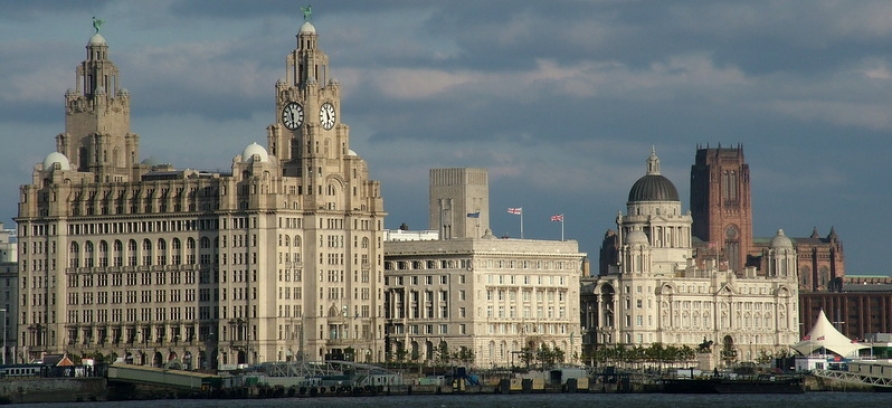
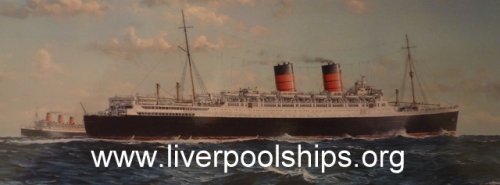
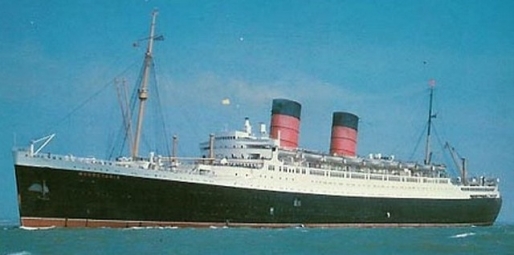
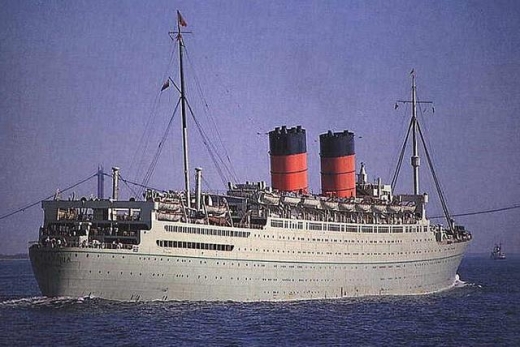
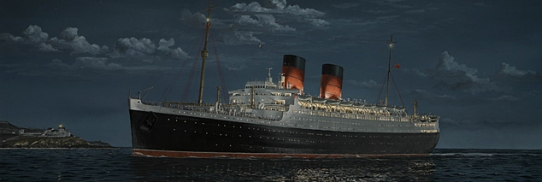
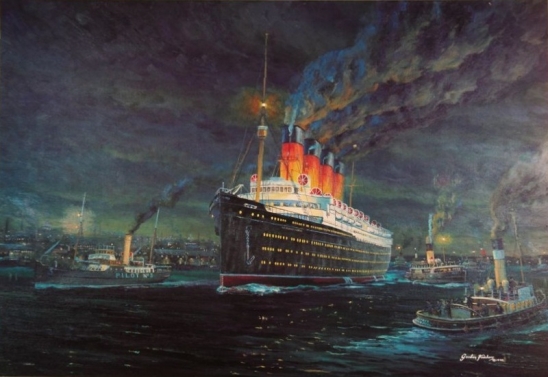
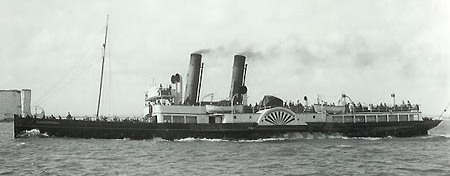 The South Coast excursion steamer QUEEN was renamed MAURETANIA
The South Coast excursion steamer QUEEN was renamed MAURETANIA